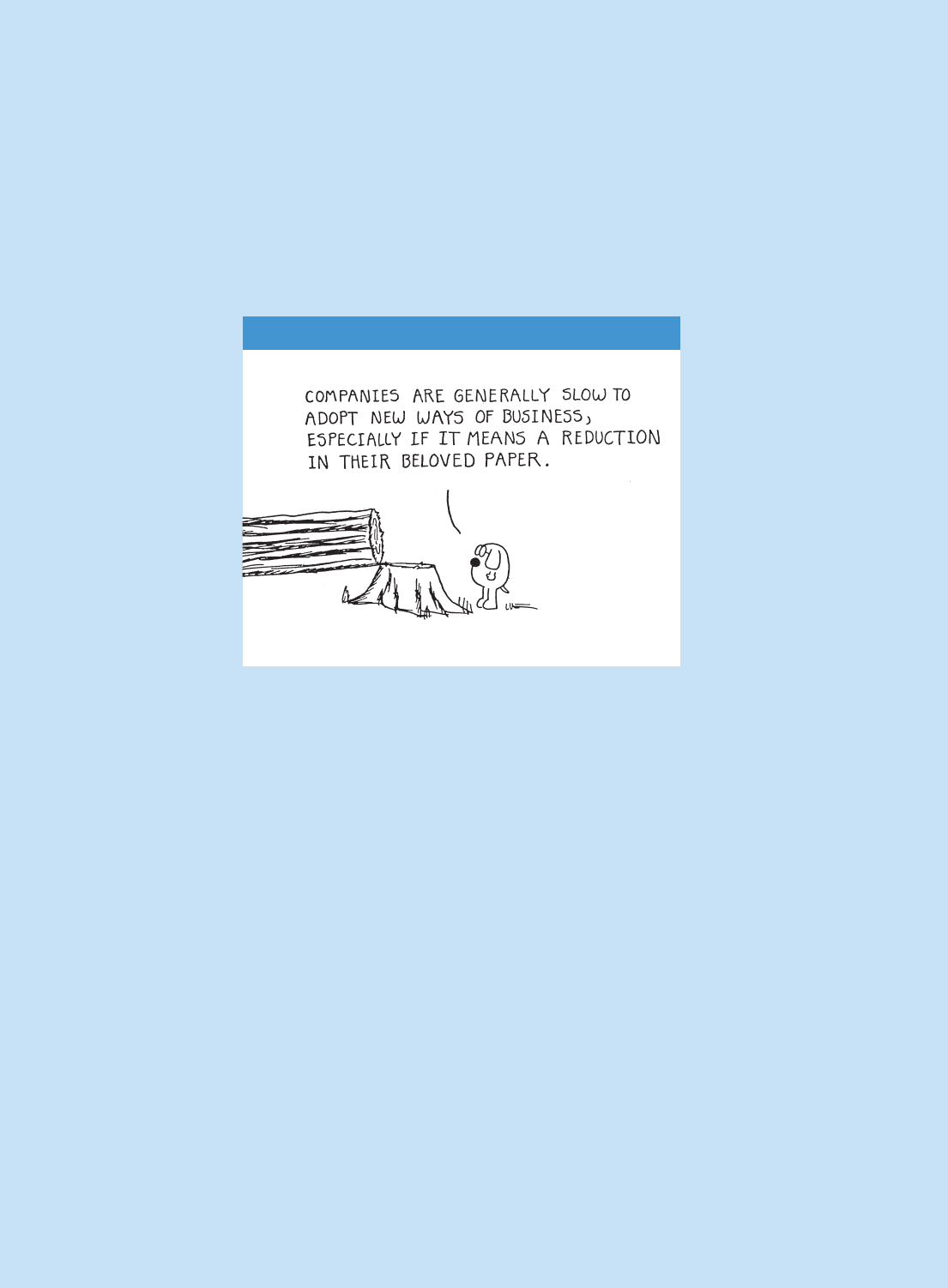Mullins L.J. Management and organisational behaviour, Seventh edition
Подождите немного. Документ загружается.


CHAPTER 20 RESOURCING THE ORGANISATION
CASE STUDY 20.1
Wessex Computers has been running for five years
now, and it is still virtually a ‘one-person business’
though there are 20 employees. While the firm sells
books, magazines and small ‘micro’ games, its busi-
ness is predominantly in microcomputers. Staff thus
spend their time in selling computers and persuad-
ing clients that package programs are applicable to
their business or in providing software packages to
suit individual requirements. The employees are
nearly all in the 20–25 age group, and very keen and
interested in their jobs, obviously involved in learn-
ing a trade which has every prospect going for it in
the years ahead. Every opportunity is taken to dis-
play their wares at computer shows and exhibitions
and to help in running courses on micros in an
effort to make people aware of the ‘user-friendly’
nature of the equipment.
The site of the main part of the business is in what
was once a main shopping street but has now been
bypassed, and is in fact a cul-de-sac. The premises con-
sist of a small shop front with 600 square feet of
shopping area in which are displayed microcomputers,
books, computer games, calculators and standard soft-
ware. Behind is a workroom, and above more
workrooms and office space, in all 3000 square feet.
Over the shop itself lived a tenant, who has just left
the property so that another 1000 square feet has
become available. The proprietor hopes to use this to
solve the storage problems and to create one large
room which can be used for setting up a permanent
training section. His idea is to charge customers a
moderate fee so that their employees can be taught
how to run their computers. The staff currently con-
sists of the proprietor, a secretary/bookkeeper, three
receptionists/assistants and seven programmers/cus-
tomer support staff. As this is a small organisation and
somewhat overworked the specific tasks are flexible
and depend on individual preferences.
The other part of the premises is about five miles
away in Embridge; three years ago Wessex Computers
won a local ‘Enterprise’ competition run by the cor-
poration, for which the prize was this site rented at a
reduced cost. It is used as working quarters for five pro-
grammers, two customer support staff involved in
repairing and servicing the microcomputers and two
administrative staff. Control of these staff and effective
charging-out of their work to customers has not
proved very satisfactory.
As far as Wessex Computers is concerned, some suc-
cess has been achieved by lending out the
microcomputers free of charge for about ten days or by
renting them out at a minimal charge for a month or
two so that customers have a chance to get acquainted
with them. Ninety per cent of such clients end by
buying the machine and to some extent the rental
could be offset against the capital cost. The owner is
considering going into the leasing business as poten-
tial buyers are worried about machines becoming
quickly outdated; a financing company deals with the
funding of this side of the business. Maintenance work
has to be done at times, although most frequently
problems are caused by either mishandling of floppy
disks by the customers, or failure to read the instruc-
tion handbooks carefully. Staff have to spend about
one or two hours with each customer teaching them
to use the machines even though comprehensive
instruction manuals are available.
Some six months ago, with everyone working
particularly hard, the record keeping was neglected,
and the overdraft increased rapidly. The bank
became nervous and was only reassured when an
independent accountant was called in to complete
the year’s accounts, and to produce a report and
cash flow forecast for a few months ahead.
Among the accountant’s remarks was the com-
ment that the owner was working far too hard, for
too many hours, trying to be sales manager, general
manager and office manager. Obviously this pressure
of work could not be maintained and some aspect of
his work had to be shed. Since the least interesting
part of the business for him was the ‘paperwork’, and
the most interesting was selling microcomputers,
meeting people and solving problems with them, he
decided to appoint an office manager to take control
of office procedures, in the most convenient way.
YOUR TASKS
(a) Produce a job description and person specifica-
tion for the appointment of the office manager.
(b)
Prepare a press advertisement covering the vacancy
and list other sources which could be used.
(c) Describe the methods of employment selection
which could be used.
(Make clear any reasonable assumptions you feel are necessary.)
825
Please enter your password: effective resource management
at Wessex Computers

826
PART 7 MANAGEMENT OF HUMAN RESOURCES
CASE STUDY 20.2
Inky fingers: HRM failure at Sumprint Ltd
Sumprint Ltd was established in the mid-1980s as a
partnership. The enterprise was converted to a private
limited company in the second year of operation.
The shares were wholly owned by members of the
two families of the original founders.
The business was initially concerned with print-
ing of leaflets, club newsletters and similar small
jobs. This aspect of the company’s activities had
been largely superseded by firm contracts for print-
ing technical manuals and brochures.
By the end of 2000 the company had grown to
employ around 180 staff. Fifty of these employees
were engaged in marketing, finance, administration
and personnel functions. There was minimal inter-
action between these functions and each tended to
operate as separate entities.
The financial department and small marketing
section kept the general operation of the sales and
production activities closely under their supervision.
The administration department operated all the
monitoring and control systems and provided clerical
support to finance, sales and production. The func-
tion was well organised and was managed by the
daughter of the founders. She had gained consider-
able working experience, initially with a large charity
and subsequently as office manager in a small engi-
neering business. She had held her present post for
four years and had acquired a high level of self-
assurance. Her confident manner made her dealings
with the other departments easier to manage. Indeed,
on some occasions it made the situation possible.
The same level of development and attention had
not been give to the personnel aspects of the business.
This function had always tended to receive less atten-
tion and had been without any designated person in
charge for some months. Now that the Directors had
taken on an experienced Personnel Manager there
were hopes that the situation would improve.
Almost of necessity each department had handled
their own personnel needs. With this background it
was no surprise to the new Personnel Manager that
there was little in the way of formal systems and pro-
cedures. He was working on these when there was an
incident in the production department.
The supervisor wished to take disciplinary action
against an employee for disobeying an instruction
and the employee wished to register a grievance
against the supervisor for the way the supervisor had
acted. This situation, if properly handled, would pro-
vide the Personnel Manager with the opportunity to
show the importance of the function.
At the same time the Administration Manager
had employed two new staff to start at the begin-
ning of the next month. This gave her three weeks
to produce an induction programme.
One of the prospective employees was a mature
woman with considerable experience of office rou-
tine while the other was an eighteen-year-old
straight from college.
The Administration Manager knew she would get
no help from personnel as she had always been very
critical of the way the personnel function had been
neglected. In contrast to this she offered some assis-
tance to the Personnel Manager, both personally
and by two of the staff. Unfortunately, this offer was
rejected in a rather offhand manner. He said that he
wanted to sort things out himself.
The purchasing of materials and general items had
always been the responsibility of the Administration
Manager, but stock control and the small warehouse
was the responsibility of the Production Supervisor.
The arrangement normally worked satisfactorily, but
when there was a breakdown on the flow of informa-
tion, production could be interrupted.
YOUR TASKS
(a) Discuss the weakness of the informal structure in
Sumprint and suggest how improvements could
be made.
(b) Advise the Personnel Manager on the immediate
way forward in the combined disciplinary and
grievance case.
(c) Discuss the approach the Administration Manager
should take to devise the induction programme
for the two new staff.

CHAPTER 20 RESOURCING THE ORGANISATION
827
NOTES AND REFERENCES
1. West, M. and Patterson, M. ‘Profitable Personnel’,
People Management, 8 January 1998, p. 29.
2. Riches, A. ‘How Do You Attract and Retain the Best
People?’ Organisational Change & Leadership Development,
www.anneriches.com.au, accessed 11 March 2003.
3. Rabey, G. ‘The Changing World of Job Recruitment
and Selection’, New Zealand Management, vol. 49, no.
10, November 2002, pp. 38–41.
4. Holloway, A. ‘Finding the Right Fit’, Canadian Business,
vol. 75, no. 22, 25 November 2002, pp. 119–22.
5. Beardwell, I., Holden, L. and Claydon, T. Human
Resource Management: A contemporary approach, Fourth
edition (2004), p. 181.
6. Recruitment and Induction, Advisory Booklet, ACAS,
April 2003, p. 7.
7. Torrington, D., Hall, L. and Taylor, S. Human Resource
Management, Fifth edition, Financial Times Prentice
Hall (2002), p. 63.
8. William Mercer Frazer Ltd. Manpower Planning Survey
Report, August 1989.
9. Recruitment and Induction, Advisory Booklet, ACAS,
April 2003, p. 5.
10. See, for example: Mullins, L. J. ‘Job Analysis – Know
the Job and the Person to Do It’, International Journal of
Hospitality Management, vol. 4, no. 4, 1985, pp. 181–3.
11. Senter, A. ‘Recruiting to Stop the Revolving Door’,
Management Today, February 1999, pp. 80–2.
12. Townsend, R. Further up the Organisation, Coronet
Books (1985), pp. 115–16.
13. Belbin, R. M. Changing the Way we Work, Butterworth-
Heinemann (1997), p. 13.
14. Peters, T. Thriving on Chaos, Pan (1989).
15. Plachy, R. J. ‘Writing Job Descriptions that Get Results’,
Personnel, vol. 64, no. 10, October 1987, pp. 56–63.
16. Employment Department Group, Equal Opportunities:
Ten Point Plan for Employers, 1999.
17.
See for example: ‘Why Employers Must Look Further
than Usual Suspects’, Employment News, no. 285, February
2001, Department for Education and Employment.
18. Cane, D. Kaizen Strategies for Winning Through People,
Pitman Publishing (1996), p. 75.
19. Rodger, A. and Cavanagh, P. ‘Personnel Selection and
Vocational Guidance’, in Welford, A. T. et al. (eds)
Society: Problems and Methods of Study, Revised edition,
Routledge and Kegan Paul (1967).
20. Garcia, B., Meador, M. G. and Kleiner, B. ‘ How to Hire
the Right Person the First Time’, Nonprofit World, vol.
21, no. 2, March/April 2003, pp. 9–11.
21. Simms, J. ‘Unnatural Selection’, Director, vol. 56, no. 8,
March 2003, pp. 70–4.
22. Armitage, K. ‘Fine … But What Do You Actually Mean?’,
The British Journal of Administrative Management,
January/February 1998, p. 22.
23. Reed, J. ‘The Scatter-gun Approach’, People Management,
26 October 2000, p. 69.
24. Lucas, E. ‘Online Talent Pool’, Professional Manager, vol.
12, no. 2, March 2003, pp. 29–32.
25. ‘Effective Organisations: the People Factor’, Advisory
Booklet, ACAS, November 2001, p. 20.
26. Some of the ideas expressed are based on the author’s
experience as a visiting selector for a number of organi-
sations, including study of the selection process for
long-term volunteers with the United Nations
Association International Service.
27. See, for example: Thatcher, M. ‘A Test of Character’,
People Management, 15 May 1997, pp. 34–8.
28. Lucas, E. ‘Virtual Realities of Candidate Selection’,
Professional Manager, March 1999, pp. 10–12.
29. Barrett, R. S. ‘Guide to Using Psychological Tests’, in
Fleishman, E. A. (ed.) Studies in Personnel and Industrial
Psychology, Revised edition, Dorsey Press (1967), p. 58.
30. See, for example Furnham, A. The Psychology of
Behaviour at Work, Psychology Press (1997); and
Wilson, C. ‘Tough Choices’, The British Journal of
Administrative Management’ May/June 1999, pp. 10–12.
31. Anastasi, A. Fields of Applied Psychology, McGraw-Hill
(1964), p. 71.
32. See, for example: Shipton, H., Shackleton, V. and
Gillespie, M. ‘Assessment Centres’, People Management,
8 January 1998, pp. 41–2.
33. See for example: Burn, A. ‘Testing times’, The British
Journal of Administrative Management, November/
December 1998, pp. 16–17.
34. Butcher, D. ‘The Interview: Rights and Wrongs’,
Management Today, April 2002, pp. 52–7.
35. Losyk, B. ‘How to Hire the Right People’, Public
Management, vol. 85, no. 5, June 2003, pp. 24–6.
36. See, for example: Green, J. ‘Pride and Prejudice: Playing
Fair in the Interview’, Administrator, April 1996,
pp. 18–19.
37. See, for example: Muir, J. ‘Nobody Expects the Spanish
Inquisition’, Chartered Secretary, June 1996, pp. 26–7.
38. Simons, T. ‘Interviewing Job Applicants – How to Get
Beyond First Impressions’, Cornell Human Resource
Administration Quarterly, December 1995, pp. 21–7.
39. See, for example: Glaser, C. B. and Smalley, B. S. ‘Four
Minutes That Get You a Job’, Reader’s Digest, January
1994, pp. 69–72.
40. See for example: Pilbeam, S. and Corbridge, M. People
Resourcing: HRM in Practice, Second edition, Financial
Times Prentice Hall (2002).
41. Farnham, D. and Stevens, A. ‘Developing and
Implementing Competence-based Recruitment and
Selection in a Social Services Department: a Case Study
of West Sussex County Council’, The International
Journal of Public Sector Management, vol. 13, no. 4, 2000,
pp. 369–82.
42. Whiddett, S. and Kandola, B. ‘Fit for the Job?’, People
Management, 25 May 2000, pp. 33–8.
43. Moloney, K. ‘History Repeating’, People Management, 6
July 2000, pp. 43–6.
44. Meyrick, M. ‘In Search of Excellence’, The British Journal
of Administrative Management, September/October 2001,
pp. 24–5.

828
PART 7 MANAGEMENT OF HUMAN RESOURCES
45. See, for example: Green, J. ‘Pride and Prejudice: Playing
Fair in the Interview’, Administrator, April 1996,
pp. 18–19.
46. Drucker, P. F. ‘Getting Things Done: How to Make
Good People Decisions’, Harvard Business Review, vol. 4,
July–August 1985, p. 22.
47. Recruitment and Induction, Advisory Booklet, ACAS,
April 2003, pp. 34–5.
48. See, for example: Tyson, S. and Fell, A. Evaluating the
Personnel Function, Second edition, Stanley Thornes
(1992).
FT
Use the Financial Times to enhance your understanding of the context and practice of management and
organisational behaviour. Refer to articles 3, 21, 22 and 24 in the BUSINESS PRESS section at the end of
the book for relevant reports on the issues explored in this chapter.

IMPROVING
ORGANISATIONAL
PERFORMANCE
Part 8
Part 2
THE
ORGANISATIONAL
SETTING
Part 3
THE ROLE OF
THE MANAGER
Part 6
ORGANISATIONAL
STRUCTURES
Part 7
MANAGEMENT
OF HUMAN
RESOURCES
Part 5
GROUPS AND
TEAMWORK
Part 1
MANAGEMENT AND
ORGANISATIONAL
BEHAVIOUR
Part 4
THE
INDIVIDUAL
Part 8
IMPROVING
ORGANISATIONAL
PERFORMANCE

Technology and innovation

Despite the bad odour that clings to the very
notion of power because of the misuses to which
it has been put, power in itself is neither good nor
bad. It is an inescapable aspect of every human
relationship.
Alvin Toffler
Powershift, Bantam (1990)
The success of any form of social influence or
control depends ultimately upon altering the
ability of others to achieve their goals or satisfy
their needs.
Douglas McGregor
The Human Side of Enterprise, McGraw-Hill (1960)
An underlying feature of the
people–organisation relationship is
management control and power. Control
systems exist in all spheres of the operations of
the organisation and are a necessary part of the
process of management. Work organisations
are complex systems of social relationships,
status and power and attention should be
given to the manager–subordinate
relationships. The manager needs to
understand the nature of power and control in
order to improve organisational performance.
1
LEARNING OUTCOMES
After completing this chapter you should be able to:
explain the nature and importance of control as an
integral part of the process of management;
identify the essential elements in a management
control system, and different forms and classifications
of control;
detail characteristics of an effective control system,
and examine the importance of behavioural factors;
explain the nature of power and management control,
and review perspectives of organisational power;
explore the process of delegation, and detail a
planned and systematic approach to delegation;
examine the concept and importance of empowerment;
assess the nature and impact of financial and
accounting systems of control.
ORGANISATIONAL CONTROL
AND POWER
21
Photo: Belinda Lawley/Panos Pictures

In our discussion of the nature of management (Chapter 6) we drew attention to the
motivation of staff and the importance of control over the performance of other
people’s work. Tannenbaum, for example, sees control as an inherent characteristic of
the nature of organisations. The process of control is at the centre of the exchange
between the benefits that the individual derives from membership of an organisation
and the costs of such benefits.
Organization implies control. A social organization is an ordered arrangement of individual
human interactions. Control processes help circumscribe idiosyncratic behaviors and keep them
conformant to the rational plan of the organization. Organizations require a certain amount of
conformity as well as the integration of diverse activities. It is the function of control to bring
about conformance to organizational requirements and achievement of the ultimate purposes of
the organization.
2
Control is therefore an integral part of the process of management.
Management control is primarily a process for motivating and inspiring people to perform organ-
ization activities that will further the organization’s goals. It is also a process for detecting and
correcting unintentional performance errors and intentional irregularities, such as theft or
misuse of resources.
3
According to Tulgan, ‘control’ (together with timing and customisation) is one of the
three factors that should guide rewards and incentives in the workplace of the future.
‘It is critical to make very clear to individual contributors exactly what performance –
what results, within what guidelines, parameters and deadlines – the organization
needs, and will therefore reward.’
4
Control is also often associated with the act of delegation. For example, Payne and
Payne define control as: ‘monitoring the performance of the delegated task so that the
expected results are successfully achieved’. However, this does not imply that control is
undertaken only by the manager. The person to whom the task is delegated can also
often effectively identify and operate day-to-day controls.
5
Delegation and empower-
ment are discussed later in this chapter.
Control can stand for reliability, order and stability. Whenever a person inquires ‘I
would like to know how well I am doing’, this in effect can be seen as asking for con-
trol. Members of staff want to know what is expected of them and how well they are
performing. This places emphasis on the exchange of information, and feedback and
comparison of actual results against planned targets. Control is a basis for training
needs, the motivation to achieve standards and for the development of individuals.
6
However, as Wilson, for example reminds us, individuals are not just passive objects
of control: ‘They may accept, deny, react, reshape, rethink, acquiesce, rebel, or conform
and create themselves within constraints impose on them.’
7
Most people show an ambivalence towards control. While they may not wish to
have them applied by other people to their own performance they recognise the need
for, and usefulness of, control systems. Under certain conditions, however, people may
actually desire control. Lawler, for example, gives three reasons why employees might
want to be subject to a control system:
■ to give feedback about task performance;
■ to provide some degree of structure of tasks, definition of how the tasks are to be
carried out, and how performance will be measured; and
■ where reward systems, for example pay, are based on performance.
8
832
PART 8 IMPROVING ORGANISATIONAL PERFORMANCE
THE MEANING OF CONTROL
Individual
behaviour

At the organisational level, management need to exercise ‘control’ over the behaviour
and actions of staff in order to ensure a satisfactory level of performance. Managerial
control systems are a means of checking progress to determine whether the objectives
of the organisation are being achieved. According to Zimmermann, for example, an
organisation without control is impossible.
Every organization has control systems that co-ordinate the exercise of decision rights that are
dispersed among individuals. Control systems also serve another important function in the
organization. They measure how effectively decisionshave been translated into results. This
second feature of control systems relates to the goal achievement of the company. In this per-
spective, control systems are about influencing the behaviour of individuals in the interest of the
corporation. Both functions are closely interlinked.
9
Control completes the cycle of managerial activities. It involves the planning and
organisation of work functions, and guiding and regulating the activities of staff.
Control provides a check on the execution of work and on the success or failure of the
operations of the organisation. The whole purpose of management control is the
improvement in performance at both the individual and organisational level. (See
Figure 21.1.) Lack of adequate supervision and control, or of an effective risk-manage-
ment system, are a major feature of poor organisational performance and can even lead
to the collapse of a company.
10
A major international report undertaken by Proudfoot
Consulting found that poor management in terms of inadequate planning and control,
and insufficient day-to-day supervision of work is still the largest single reason for lost
productivity.
11
The controversial nature of control
The concern for the regulation of behaviour and improvement in performance raises
questions as to the ethical nature of control. For example, in discussing the goals of
organisational behaviour (OB) Robbins makes the following observation:
The most controversial goal is using OB knowledge to control behavior. When a manager asks,
for instance: ‘What can I do to make Dave put more effort on his job?’ that manager is concerned
with control. Why is control controversial? A democratic society is built upon the concept of
CHAPTER 21 ORGANISATIONAL CONTROL AND POWER
833
Organisational
performance
Figure 21.1 The nature of management control

personal freedom. Therefore, the idea that one person should attempt to get others to behave in
some premeditated way, when the subjects of that control may be unaware that their behavior is
being manipulated, has been viewed in some circles as unethical and/or repugnant … However,
you should be aware that the control objective is frequently seen by managers as the most valu-
able contribution that OB makes towards their effectiveness on the job.
12
Unfortunately, ‘control’ often has an emotive connotation and is interpreted in a nega-
tive manner to suggest direction or command by the giving of orders. By their very
nature, control systems are concerned with the regulation of behaviour. People may be
suspicious of control systems and see them as emphasising punishment, an indication
of authoritarian management, and a means of exerting pressure and maintaining disci-
pline. Some writers seem to take this view, and even to suggest that organisational
control is exploitation of employees.
13
This is too narrow an interpretation, however. There is far more to control than
simply a means of restricting behaviour or the exercise of authority over others.
Control is not only a function of the formal organisation and a hierarchical structure
of authority. It is also a feature of organisational behaviour and a function of interper-
sonal influence.
14
Control is, therefore, a general concept which is applied to both
individual behaviour and organisational performance. Nevertheless, we should
note, for example, the comments by Drummond who in a critical discussion about
mechanistic thinking in organisations makes the point: ‘common sense suggests that
control is preferable to anarchy, and more control is preferable to less. While such
assumptions are not necessarily wrong, they are not universally correct either.’
15
In a discussion of management processes in the new century, Lorange notes that the
control process will also change dramatically:
Perhaps the name ‘control’ will no longer exist, given the behaviourally dysfunctional overtones
that tend to come with it. We shall, however, still use it here as a convenient term of reference,
and remember that the content behind the phenomenon will be dramatically different.
16
One view of control is based on the classical approach and traditional assumptions of
organisation and management. Control is viewed as an essential feature of formal organ-
isation and a hierarchical structure of authority. It may also be recalled that the idea of
‘Taylorism’ and scientific management (discussed in Chapter 3) can be seen as represent-
ing a form of management control over workers and the actual process of work. A
distinguishing feature of scientific management was that workers should be controlled
not only by the giving of orders and maintenance of discipline, but also by removing
from them decisions about the manner in which their work was to be carried out.
17
The traditional view assumes the amount of control is fixed. It is based on the use of
routine procedures, and the exercise of rules and regulations in an attempt to create
consistency and predictability in behaviour. As a consequence of their status and posi-
tion within the hierarchical structure, managers have control over the flow of
information which mainly moves down the organisation through vertical lines of com-
munication. For example, Argyris maintains that traditional forms of managerial
controls tend to create situations in which the employees feel dependent on their super-
iors and fearful of the staff in charge of the various types of control.
18
By contrast, the human relations approach places emphasis on the social organisa-
tion, and the importance of groups and informal relationships. Control is seen more as
a feature of interpersonal influence and takes place within a network of interaction and
communications. Those writers who place emphasis on the social needs of individuals
within the work organisation tend to see a high level of control as self-defeating. It
834
PART 8 IMPROVING ORGANISATIONAL PERFORMANCE
ASSUMPTIONS OF ORGANISATION AND MANAGEMENT
